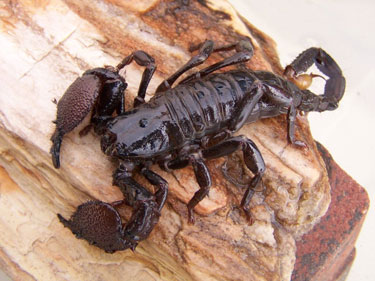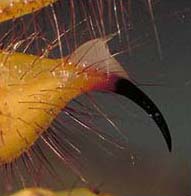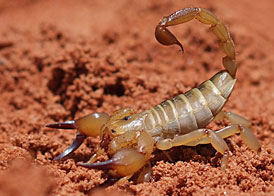Scorpions
What are scorpions?

Scorpions are venomous athropods of the class Arachnida and are considered relatives of the spiders, mites, ticks and harvestmen.
There are approximately 1,300 species of scorpions worldwide. The body of the scorpion is divided into two parts, the cephalothorax and the mesosoma or preabdomen. The cephalothorax contains all of the sensory, locomotion, and feeding appendages. Two pairs of chelicerae, positioned on either side of the mouth, allow the scorpion to rip and tear its prey while feeding. The pedipalps (pincers) are used for sensing as well as holding prey while envenomating or eating
Like all arachnids, scorpions have four pairs of jointed legs. Sensory hairs on the legs can detect the vibrations of prey up to 1 foot (30 cm) away.
Scorpion venom

Scorpion venoms are complex mixtures of neurotoxins (toxins which affect the victim's nervous system) and other substances; each species has a unique mixture. Despite their bad reputation, only one species in the U.S. and about 20 others worldwide have venom potent enough to be considered dangerous to humans.
The world's most dangerous scorpions live in North Africa and the Middle East (species of Androctonus, Buthus, Hottentotta, Leiurus), South America (Tityus), India (Mesobuthus), and Mexico (Centruroides). In some of these areas, scorpion stings may be a significant cause of death.
Where can they be found?

Scorpions are commonly thought of as desert animals, but also occur in many other habitats as well, including grasslands and savannahs, deciduous forests, pine forests, rain forest and caves.
Scorpions have even been found under snow-covered rocks at elevations of over 12,000 feet in the Andes Mountains of South America and the Himalayas of Asia. About 90 species occur in America, and all but four of these naturally occur west of the Mississippi River.